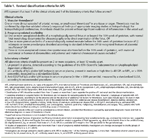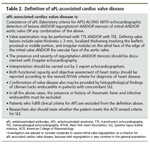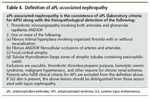Article
The Sydney Classification Criteria for Definite Antiphospholipid Syndrome
The original antiphospholipid syndrome (APS) classification criteria (the Sapporo criteria), published in 1999, helped galvanize research in this disorder.1 New clinical, laboratory, and experimental insights gained since then were addressed at the Eleventh International Congress on Antiphospholipid Antibodies in Sydney, Australia, in 2006.
ABSTRACT: Amendments to the Sapporo criteria for antiphospholipid syndrome (APS) addressed clinical, laboratory, and experimental insights gained since they were adopted in 1999. A committee of experts concurred that patients with APS should be stratified according to the presence or absence of other (inherited or acquired) contributing causes of thrombosis. It was agreed that there are inherent problems in applying the pregnancy-related morbidity criterion in practice and research because there is no widely accepted definition for placental insufficiency or characteristic histopathological placental abnormality in APS. Both lupus anticoagulant and anticardiolipin antibodies were maintained as laboratory criteria. The issue of several other APS-related conditions (cardiac, neurological, skin, or renal; thrombocytopenia) also was addressed. The newer criteria have several advantages over the older ones but also have limitations. (J Musculoskel Med. 2012;29:73-77)
The original antiphospholipid syndrome (APS) classification criteria (the Sapporo criteria), published in 1999, helped galvanize research in this disorder.1 New clinical, laboratory, and experimental insights gained since then were addressed at the Eleventh International Congress on Antiphospholipid Antibodies in Sydney, Australia, in 2006.2 On the basis of these discussions, amendments to the Sapporo criteria were proposed. The newer criteria have many advantages over the older ones.
This is the fourth article in a series on new or modified classification and diagnostic criteria for various rheumatologic conditions. The first article (“New Classification Criteria for RA,” The Journal of Musculoskeletal Medicine, November 2011, page 422) discussed recent revisions in rheumatoid arthritis classification criteria. The second article (“New Axial and Peripheral Spondyloarthritis Classification Criteria,” The Journal of Musculoskeletal Medicine, December 2011, page 454) reviewed the new classification criteria for the spondyloarthropathies. In the third article (“New and Modified Fibromyalgia Diagnostic Criteria,” The Journal of Musculoskeletal Medicine, February 2012, page 13), we discussed the new American College of Rheumatology diagnostic criteria for fibromyalgia syndrome and their modification as survey criteria. In this article, we focus on revised classification criteria for APS.
The Need for New Criteria
Although the Sapporo criteria were found to have high sensitivity and specificity in APS seen in conjunction with lupus and lupus-like disease,3 very few studies have validated these criteria.3,4 The Sapporo criteria performed poorly in older populations because of the high frequency of antiphospholipid antibodies (aPL) along with frequent thromboembolic disease in hospitalized patients. There were no clear cutoffs for “medium to high titers” of IgG and IgM anticardiolipin (aCL) antibodies, and the issue of difference in timing of laboratory testing in relation to the clinical event was not clarified adequately in the original criteria. Also, various clinical entities associated with APS were a source of major confusion.
The Process of Developing New Classification Criteria
A panel consisting of 39 experts from around the world met and discussed various issues regarding APS classification at a workshop held during the international congress. Recommendations were made on the basis of level of evidence in the usual manner. The Sapporo classification criteria were divided into “clinical” and “laboratory” categories; this categorization was maintained in the revision. Special attention was paid to defining some terms that were thought to be described ambiguously in the older criteria.
Thrombotic phenomenon. The committee concurred that additional factors that contribute to thrombosis should be assessed. They agreed that patients with APS should be stratified according to (a) the presence or (b) the absence of other (inherited or acquired) contributing causes of thrombosis (Table 1).5
TABLE 1

Revised classification criteria for APS
Pregnancy-related morbidity. It was agreed that there are inherent problems in applying this criterion in practice and research because there is no widely accepted definition for placental insufficiency or characteristic histopathological placental abnormality in APS and the timing of delivery usually is subject to the attending physician's judgment.6 To avoid misclassification, the experts recommended strict adherence to conventional clinical definitions of eclampsia, severe preeclampsia,7,8 and placental insufficiency (see Table 1). They also recommended that this criterion be considered positive in the presence of any of the above along with the decision of a qualified physician to deliver a morphologically normal fetus before 34 weeks of gestation.
Laboratory criteria. Both lupus anticoagulant (LA) and aCL antibodies were maintained as laboratory criteria in the revision. In addition, IgG, IgM, and anti-β2 glycoprotein-1 (anti-β2GP1) assays were added by a majority on the basis of the extent of clinical evidence.3,9,10 It was thought that the thresholds to distinguish moderate to high titers of IgG and IgM aCL antibodies from low levels had no standardized definition and were difficult to define.11,12 The committee introduced a clear statement on the threshold for a positive finding (see Table 1) on the basis of best available evidence.13-17
The evidence suggested a more severe disease course with multiple aPL positivity. Therefore, the revised criteria subclassify patients with APS into 4 categories on the basis of number of aPL assays that have positive findings (see Table 1).18-21
The issue of the timing of laboratory testing in relation to the event was not clarified adequately in the original criteria. The new criteria suggest that at least 12 weeks between the symptom and the laboratory test is appropriate and state that there should not be a time lapse of more than 5 years between the clinical event and the test to classify as APS.
Persistent positivity of the laboratory test finding is important for making a diagnosis of APS. The Sapporo criteria suggested an interval of 6 weeks between 2 positive test results. However, a concern has been that the transient presence of aPL could be a common epiphenomenon in clinical practice that may risk misclassification.22,23 The revision suggests increasing this interval to 12 weeks, which is unlikely to affect sensitivity and coupled with the previous proposal of time difference between clinical and laboratory event provides greater reassurance that the aPL detected actually is predisposing to APS.
The experts addressed the concept of “secondary APS.” The committee advised against using the term. Most patients with secondary APS have systemic lupus erythematosus (SLE), and the interplay between these 2 entities when present together in a patient-whether they are part of same disease or 2 separate diseases or 1 predisposes to the other-remains unclear. Therefore, the Sydney criteria propose that documenting the coexistence of SLE and APS is more appropriate than classifying patients as having “primary” or “secondary” APS. The entity of catastrophic APS was not addressed because a consensus statement had been issued in 2003.24
Other APS-Related Conditions Addressed
The issue of several other APS-related conditions, a common source of confusion, also was addressed. These conditions have been addressed separately in the Sydney document as “features associated with APS but not included in revised criteria.” They are summarized in Tables 2 - 4 and include the following 5 clinical and 6 laboratory entities:
TABLE 2

Definition of aPL-associated cardiac valve disease
• Cardiac. The committee provided relevant definitions of heart valve lesions in APS (see Table 2). The following recommendations are made: against adoption as a criterion; against routine testing in all patients with coronary artery disease, unless a patient’s young age and lack of identifiable risk factors suggest another cause; and recognizing rare cases with biopsy-proven myocardial microthrombosis or intracardiac thrombi as meeting the thrombosis criteria for APS.
TABLE 3

Definition of aPL-associated livedo reticularis
• Neurological. Several neurological manifestations may be associated with APS. The committee concluded that there was insufficient evidence to include cognitive dysfunction, headache or migraine, multiple sclerosis, transverse myelitis, and epilepsy in the revised criteria but recommended that the data suggesting cognitive decline warrant further study.
• Skin. Livedo reticularis (LR) has been associated with APS, and the revision provides a definition of LR-associated APS (see Table 3). Routine biopsy is not recommended because there are no pathognomonic findings. Many other skin manifestations are not included in the new criteria.
• Renal. The committee recommended the term “aPL-associated nephropathy” (aPLN) to describe renal involvement in APS, and specific definitions were provided (see Table 4). General guidelines include the following: aPLN lesions are similar in SLE- and non–SLE-related APS; they are independent of lupus nephritis and do not correlate with progression to end-stage renal disease; most lesions represent chronic nonspecific vascular damage apart from thrombotic microangiopathy, which is an acute event; and patients with histologically proven aPLN satisfy the revised APS thrombosis criteria, but routine renal biopsy is not recommended in all patients with APS and should be guided by conventional clinical indications.
• Thrombocytopenia. Isolated thrombocytopenia in patients with persistent aPL, in the absence of other clinical manifestations of APS, is not the same as idiopathic thrombocytopenia; patients are at increased risk for thrombosis and should be monitored closely. The committee proposed the term “aPL-associated thrombocytopenia” to stratify patients for clinical studies. They also provide a platelet count of less than 100 × 109/L-1 as the cutoff limit for definition of thrombocytopenia in APS.
• The following 6 laboratory tests are discussed: (1) LA, (2) aCL assay, (3) IgA aCL, (4) IgA anti-β2GP1, (5) antibodies against prothrombin alone, and (6) antibodies to phosphatidylserine-prothrombin complex. None merited inclusion in the current revision, and prospective studies were recommended.
TABLE 4

Definition of aPL-associated nephropathy
Sydney Criteria Advantages
Advantages of the Sydney Criteria over the older Sapporo classification criteria include the following:
• Having clear cutoffs for levels of IgG and IgM aCL antibodies for use in the criteria has obvious advantages. The current revision also incorporates the anti-β2GP1 antibodies, which have evidence-based clinical and prognostic significance, into the laboratory criteria.
• Subcategorization of patients with APS on the basis of coexistence of more than 1 positive laboratory test result allows for identification of high-risk patients with an increased risk of thrombosis.
• The timing of laboratory testing with respect to the clinical thrombotic/obstetric event has been better defined. The interval between 2 consecutive positive laboratory test findings has been increased and has been suggested to better correlate with APS. However, this is not evidence-based.
• Common risk factors for cardiovascular disease and conditions that confer risk for thrombosis have been clearly defined and taken into account.
• Sticking to strict guidelines regarding pregnancy-related morbidity decreases the chances of misclassification and has been strongly recommended in this update.
• Several other APS-related conditions have been clearly defined and allow for classification of these separate clinical entities within the APS spectrum of disease with reasonable clarity.
Limitations of the New Classification Criteria
The pregnancy-associated morbidity of APS remains fairly hard to discern in routine clinical practice. With the advent of better histopathological and laboratory features of placental insufficiency, this feature of APS is hoped to gain specificity and applicability in routine practice. In the current update, the authors saw no advantage in removing the preeclampsia/placental insufficiency criterion; however, well-designed, prospective studies are needed to determine the contribution of APS to the overall problem of preterm birth from severe preeclampsia or placental insufficiency.
There still is no international consensus on laboratory testing and cutoff values for aCL antibodies.13-16 This issue has been addressed in a 2011 update.25
The inclusion of the new antibody (IgM and IgG anti-β2GP1), the cutoff values for certain tests (eg, aCL and anti-β2GP1 antibodies and platelet count), and inclusion definitions of the APS-related clinical features are based mostly on “expert opinion” and have little evidence base. The sensitivity and specificity of these cutoff values and definitions in association with APS have not been validated in prospectively designed clinical studies. Similarly, the time interval between clinical and laboratory event and the new time interval between 2 positive laboratory test results have not been validated prospectively.
Assessing the truly relevant definitions remains extremely difficult because of the interplay of a multitude of factors that affect the classic clinical manifestations of APS, and that makes it difficult to attribute the clinical event to APS. The association of SLE and APS probably merits further classification because of the frequent simultaneous occurrence of these 2 conditions.
References:
REFERENCES
1. Wilson WA, Gharavi AE, Koike T, et al. International consensus statement on preliminary classification criteria for definite antiphospholipid syndrome: report of an international workshop. Arthritis Rheum. 1999;42:1309-1311.
2. Miyakis S, Lockshin MD, Atsumi T, et al. International consensus statement on an update of the classification criteria for definite antiphospholipid syndrome (APS). J Thromb Haemost. 2006;4:295-306.
3. Lockshin MD, Sammaritano LR, Schwartzman S. Validation of the Sapporo criteria for antiphospholipid syndrome. Arthritis Rheum. 2000;43:440-443.
4. Weber M, Hayem G, Meyer O. The Sapporo criteria for antiphospholipid syndrome: comment on the article by Lockshin et al. Arthritis Rheum. 2001;44:1965-1966.
5. Haemostasis and Thrombosis Task Force, British Committee for Standards in Haematology. Investigation and management of heritable thrombophilia. Br J Haematol. 2001;114:512-528.
6. Sebire NJ, Backos M, El Gaddal S, et al. Placental pathology, antiphospholipid antibodies, and pregnancy outcome in recurrent miscarriage patients. Obstet Gynecol. 2003;101:258-263.
7. American College of Obstetricians and Gynecologists. Diagnosis and Management of Preeclampsia and Eclampsia. ACOG Practice Bulletin. No 33. Washington, DC: American College of Obstetricians and Gynecologists; January 2002.
8. Branch DW, Andres R, Digre KB, et al. The association of antiphospholipid antibodies with severe preeclampsia. Obstet Gynecol. 1989;73:541-545.
9. Genvresse I, Lüftner D, Späth-Schwalbe E, Buttgereit F. Prevalence and clinical significance of anticardiolipin and anti-beta2-glycoprotein-I antibodies in patients with non-Hodgkin’s lymphoma. Eur J Haematol. 2002;68:84-90.
10. Rodriguez-Garcia JL, Bertolaccini ML, Cuadrado MJ, et al. Clinical manifestations of antiphospholipid syndrome (APS) with and without antiphospholipid antibodies (the so-called ‘seronegative APS’). Ann Rheum Dis. 2012;71:242-244.
11. Levine JS, Branch DW, Rauch J. The antiphospholipid syndrome. N Engl J Med. 2002;346:752-763.
12. Wong RC; Australasian aCL Working Party. Consensus guidelines for anticardiolipin antibody testing. Thromb Res. 2004;114:559-571.
13. Harris EN, Chan JK, Asherson RA, et al. Thrombosis, recurrent fetal loss, and thrombocytopenia: predictive value of the anticardiolipin antibody test. Arch Intern Med. 1986;146:2153-2156.
14. Finazzi G, Brancaccio V, Moia M, et al. Natural history and risk factors for thrombosis in 360 patients with antiphospholipid antibodies: a four-year prospective study from the Italian Registry. Am J Med. 1996;100:530-536.
15. Lynch A, Marlar R, Murphy J, et al. Antiphospholipid antibodies in predicting adverse pregnancy outcome: a prospective study. Ann Intern Med. 1994;120:470-475.
16. Tincani A, Allegri F, Balestrieri G, et al. Minimal requirements for antiphospholipid antibodies ELISAs proposed by the European Forum on antiphospholipid antibodies. Thromb Res. 2004;114:553-558.
17. Levine SR, Salowich-Palm L, Sawaya KL, et al. IgG anticardiolipin antibody titer > 40 GPL and the risk of subsequent thrombo-occlusive events and death: a prospective cohort study. Stroke. 1997;28:1660-1665.
18. Neville C, Rauch J, Kassis J, et al. Thromboembolic risk in patients with high titre anticardiolipin and multiple antiphospholipid antibodies. Thromb Haemost. 2003;90:108-115.
19. Obermoser G, Bitterlich W, Kunz F, Sepp NT. Clinical significance of anticardiolipin and anti-beta2-glycoprotein I antibodies. Int Arch Allergy Immunol. 2004;135:148-153.
20. Detkov, Gil-Aguado A, Lavilla P, et al. Do antibodies to beta2-glycoprotein 1 contribute to the better characterization of the antiphospholipid syndrome? Lupus. 1999;8:430-438.
21. Lee EY, Lee CK, Lee TH, et al. Does the anti-beta2-glycoprotein I antibody provide additional information in patients with thrombosis? Thromb Res. 2003;111:29-32.
22. Erkan D, Derksen W, Kaplan V, et al. Real world experience with antiphospholipid antibody tests: how stable are results over time? Ann Rheum Dis. 2005;64:1321-1325.
23. Topping J, Quenby S, Farquharson R, et al. Marked variation in antiphospholipid antibodies during pregnancy: relationships to pregnancy outcome. Hum Reprod. 1999;14:224-228.
24. Asherson RA, Cervera R, de Groot PG, et al; Catastrophic Antiphospholipid Syndrome Registry Project Group. Catastrophic antiphospholipid syndrome: international consensus statement on classification criteria and treatment guidelines. Lupus. 2003;12:530-534.
25. Tripodi A, de Groot PG, Pengo V. Antiphospholipid syndrome: laboratory detection, mechanisms of action and treatment. J Intern Med. 2011;270:110-122.




